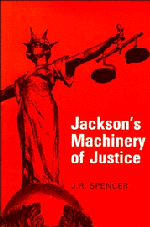Book contents
- Frontmatter
- Contents
- Acknowledgements
- List of figures
- List of tables
- Preface
- Preface to the first edition of ‘The Machinery of Justice in England’
- Abbreviations
- I Historical introduction
- II Civil jurisdiction
- 4 Civil law and criminal law
- 5 County courts
- 6 The High Court
- 7 The mode of trial
- 8 Complaints about the civil courts
- 9 The enforcement of judgments and orders
- 10 The Civil Division of the Court of Appeal and the House of Lords
- 11 The Judicial Committee of the Privy Council
- 12 Arbitration
- III Tribunals
- IV Criminal jurisdiction
- V The personnel of the law
- VI The European dimension
- VII The cost of the law
- VIII Law Reform
- Appendix A The Report of the Civil Justice Review
- Table of Cases cited
- Table of Statutes cited
- Table of Stationery Office publications cited
- Index
10 - The Civil Division of the Court of Appeal and the House of Lords
Published online by Cambridge University Press: 10 January 2011
- Frontmatter
- Contents
- Acknowledgements
- List of figures
- List of tables
- Preface
- Preface to the first edition of ‘The Machinery of Justice in England’
- Abbreviations
- I Historical introduction
- II Civil jurisdiction
- 4 Civil law and criminal law
- 5 County courts
- 6 The High Court
- 7 The mode of trial
- 8 Complaints about the civil courts
- 9 The enforcement of judgments and orders
- 10 The Civil Division of the Court of Appeal and the House of Lords
- 11 The Judicial Committee of the Privy Council
- 12 Arbitration
- III Tribunals
- IV Criminal jurisdiction
- V The personnel of the law
- VI The European dimension
- VII The cost of the law
- VIII Law Reform
- Appendix A The Report of the Civil Justice Review
- Table of Cases cited
- Table of Statutes cited
- Table of Stationery Office publications cited
- Index
Summary
From the county courts and the High Court there may be an appeal to the Court of Appeal. Appeal lies as of right from most decisions of the High Court, but county court appeals are restricted. From a county court appeal lies as of right where an injunction has been granted, where the case concerns custody of or access to a child, or where in financial terms the case is over half the maximum size that may be brought in a county court; otherwise there may be an appeal only if the county court judge or a single judge of the Court of Appeal grants leave. Since the Court of Criminal Appeal was abolished in 1966 the Court of Appeal has also heard criminal appeals from the Crown Court, and it now has a Criminal as well as a Civil Division; the Criminal Division and its work is discussed in chapter 21.
The constitution of the Court of Appeal is governed by the Supreme Court Act 1981. It has as ex officio members the Lord Chancellor, any ex-Lord Chancellor, Lords of Appeal in Ordinary, the Lord Chief Justice, the Master of the Rolls, the Vice-Chancellor and the President of the Family Division. In addition there are 22 full-time judges appointed to the staff of the Court of Appeal, who are called Lords Justices of Appeal.
- Type
- Chapter
- Information
- Jackson's Machinery of Justice , pp. 90 - 97Publisher: Cambridge University PressPrint publication year: 1989

